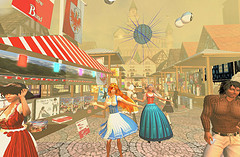Multiple personalities, multiple conflicts?
It’s not bad that a company reinvents itself. I love to give the example of IBM. In the mid-1985s, IBM, even though they had released a “home appliance” some years before, the IBM PC, was seen as a huge, grey, boring giant, which was starting to become defeated by the hippy and cool software company created by hackers like Bill Gates. Nobody was expecting anything less than seeing the giant fall and crash and disappear in the mists of computer legend — a reference to tell to granddaughters and grandsons in a future where everybody would have shiny laptops with the Windows logo stamped on them.
IBM, however, after taking some time in re-inventing itself, became a collection of cool, hippy hackers as well. The kind of software gurus that dress in flashy colours in a hip style and do things with open source in their basements reeking of Coke and Red Bull, and tackle existing projects all over the Web and make them better than Gates’ own company with their software of the 1980s. Ironically, this didn’t save IBM’s own PC division, but, well, it brought them to way unexpected areas — like developing software with Linden Lab and being thrilled with virtual worlds (note: Microsoft is around here, too 🙂 ).
The Big Blue adapted to change, did a 180º turn on their corporate image (which was not just a marketing ploy, but a real internal change), and are still here to tell the story — unlike others like, say, DEC, who are now mere footnotes in the computer history. Nobody truly believed that IBM would survive; we all expected it to fail to adapt and disappear like all others after the computer revolution of the desktop.
So dramatically adapting to dramatic change is crucial, and that’s the major reason why I, for one, I’m quite happy to see 10-year-old Linden Lab also changing their attitude towards business. But the “old” Linden Lab hasn’t disappeared: the days when Lindens and residents worked together on the beta, to create the foundations of our amazing new world, aren’t gone. In fact, far more Lindens work together with far more residents to do pretty much the same as they did six years ago. That’s not surprising: we’re so many more!
The problem here is that the two cultures rub against each other. When Linden Lab announces a typical community event (say, a fashion show) on all their channels — Message of the Day, newsletter, blog entries, and whatnot — they’re keeping alive the spirit of the Good Olde Days, when LL’s job was mostly to foster community events (do you still remember when LL’s employees used to send grid-wide messages announcing the next events to come up?). Naturally the community of residents is happy about that and quite willing to see that LL didn’t lose their touch with them, even in spite of their ongoing “corporisation”.
But on the other side of the issue, initiatives fostered by the academic world (like, say, SLACTIONS) or the business world are completely ignored. Even when businesses are actively promoting community-related events, like, say, Hair Fair ’09. This “double standard” is complex to understand, and even harder to manage. Since there is no mass-media advertising in Second Life, and no way to reach all residents with information, there is only one channel that works: LL is the only entity that has access to all residents. Access to it is crucial, but it’s unknown how to reach it. They don’t tag a price to it. They pretty much announce what they feel it’s important — be it an event or promoting in-world business — and exclude access to everybody else, even potentially paying customers.
And the crowdsourcing groups pretty much leave out the ability for businesses or even academic institutions to offer competing services. If you’re an organisation specialised in providing training services, you’d love to be able to bid for a contract to run the Help Islands — but why should LL outsource a service that it already gets for free? If you’re a software development institution, either a university or a company, you might be quite interested in developing tools and software for LL’s viewer, in the same manner that LL runs the Snowglobe project — but of course, why should LL pay for software development when it can reap the rewards of open source developers without paying anything? If you are doing content design, even at a multimedia school, you might love to get the opportunity to deploy your talent on the SL mainland and help to develop part of the mainland — but why should Linden Lab waste money doing so, when the LPDW already provides content for free?
This is a problem. LL partners — organisations, institutions, corporations — either offer their services for free to Linden Lab, or they have no choice to “compete” with the crowdsourcing efforts. But this also happens at a smaller level. Large rental facilities in SL, which might not be “big corps” but just motivated individuals who are eager to invest time and money in SL to handle communities inside SL, get competition from LL itself on the LL-run communities — with the difference that, on the mainland, LL has access to all those nifty tools to ensure safety and compliance to aesthetics. Why should anyone invest — on the individual level — in SL if LL is competing against them in land managing, building, and community management? More to the point, how can they compete against LL’s resources — who are able to use their own mass-advertising channels to promote their services on the mainland? But even small-scale software developers are always risking their investment in SL when LL moves with a product that they launch to render the small programmers’ efforts obsolete. We all remember how LindeX replaced the GOM, and how buying XStreetSL and OnRez Shop effectively left web-based e-commerce sites for digital content out of the picture. But even the stupidest gadgets can easily be outsmarted by LL — for instance, my GUUD Universal Translator is soon to become obsolete, as the latest batches of Snowglobe already include instant chat translation at a click of a checkbox. You can imagine tons of similar examples to happen with very complex HUDs that relied on prims being moved around, as soon as the Media Plugin version of the SL viewer (currently being tested under Snowglobe as well) allows all HUDs to simply become Flash/JavaScript-based — gazillions of existing gadgets will become obsolete over night. It’s part of the challenge of living on the edge of an ever-evolving world!
The question here is that these two worlds — the in-world crowdsourcing efforts, and the off-world business/academic world — overlap each other on a conflicting border, and how well Linden Lab manages that conflict.




